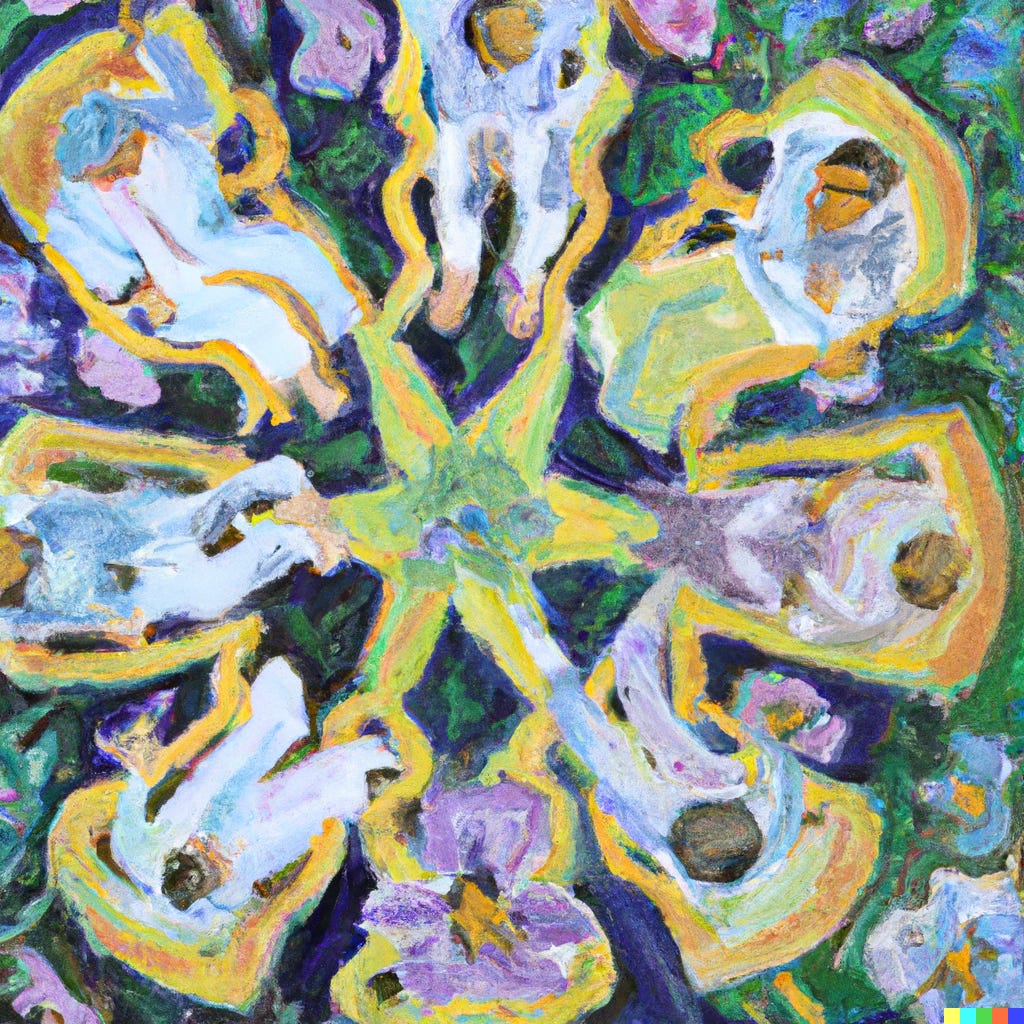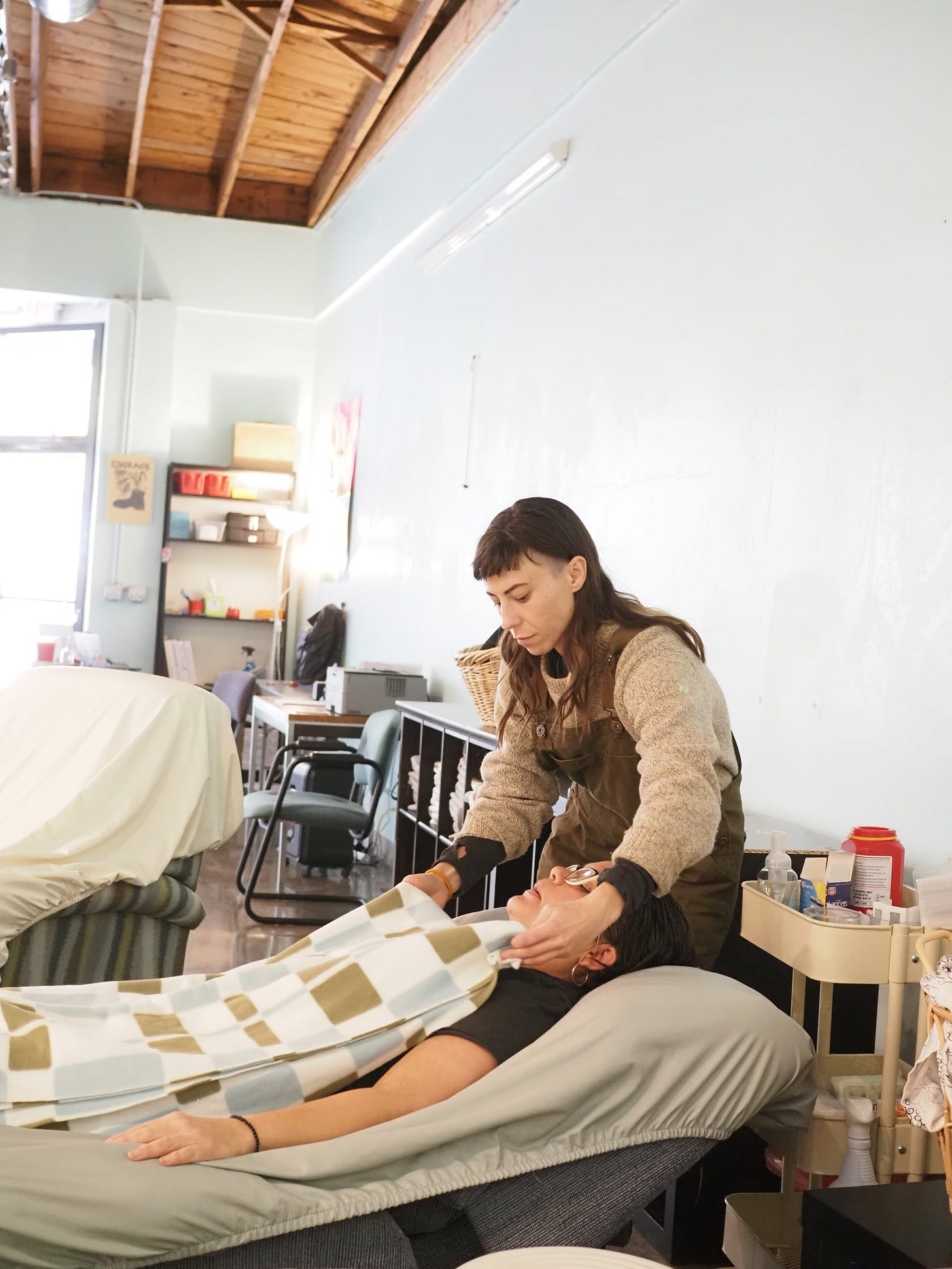Getting Up to Speed
toward a theory of gears
One of the fundamental principles of community acupuncture is that the more people you can treat per hour, the less you have to charge each of them individually. This is a post about the underlying mechanics and mindset of doing that successfully.
It’s not an argument for treating a lot of people and charging them less, because I mostly don’t argue (anymore) about whether community acupuncture deserves to exist. This post assumes that you’re open to that possibility — and also that the applications aren’t limited to community acupuncture settings. Recently I had a conversation with a couple of successful private room acupuncturists, one of them an employer and the other a business coach, who were lamenting that many acupuncturists come out of school expecting that they’ll be able to spend 90 minutes with every patient, when the reality is that many employers want them to be able to handle multiple treatments per hour (usually three). The goal there is not necessarily to charge patients less individually (as it is at WCA), but the principle is the same: there’s a mindset to doing it successfully. (The mindset could also apply to providing 5NP in a variety of settings.)
A fun thing I’ve been doing since August is supervising two second-year interns in the POCA Tech student clinic on Thursday mornings. (If you’re in Portland, come by and see us!) I got to watch them go from being brand new and understandably nervous to calm and impressively competent in seven months. Of course they’ve got room to grow, but at this point they’re practicing community acupuncture. They’re doing the thing, full stop.
One of the main skills they’re working on is time management. At POCA Tech we unapologetically call that speed.
If you want to treat a diverse range of patients and make your treatments affordable, you have to be able to treat patients simply, safely and at speed. Watching the interns as they’re getting up to speed in clinic reminded me of what it’s like to learn to drive. Specifically what it’s like to learn to drive a manual transmission aka stick shift, which I guess isn’t common anymore? (I’ve had the same car for 21 years. It’s a stick shift.) WCA acupunks have casually talked about the idea of gears, as in being able to shift into high gear when your schedule fills up, but until now we hadn’t gotten detailed about it.
It occurred to me that it’d be worth building out this idea of gears in the clinic in order to help students with those skills, so here goes:
First Gear
This is the learning gear; you’re not really driving yet, you’re attempting to drive. Just starting the car is a big deal! At POCA Tech it’s a matter of “try not to fall off your rolling stool”. (Yep, interns have fallen off their stools.) Every part of treating people is novel. You can do the thing, sort of, but each action in that sequence is separate and requires conscious thought and nothing flows automatically yet. In our program, we require brand new interns to only use Miriam Lee 10 for their first twenty treatments in clinic because they have so much else to think about that they can’t think about point selection too.
The transition from first gear to second requires:
Practice, mostly. Sheer repetition. Doing a set of tasks over and over allows you to become proficient without having to consciously focus on each individual task. For community acupuncturists in training, the set of tasks looks like rolling up to a stranger in clinic, asking them what you can do for them, and then doing it. At first this feels weird and uncomfortable and exhausting. See also: The First Hundred Treatments, 2024 Edition.
Thank you, from the bottom of our hearts, to all our patients who show up to help our interns through this stage.
Second Gear
This is the gear of being able to drive, but without speed and without having to navigate traffic. You can do the thing as long as there’s no time pressure. After you graduate, you might practice acupuncture like this IF you work in a setting where people will pay you to do what you do without time constraints (I hear that’s rare these days also). You probably don’t have any strategies for going faster because that isn’t your goal; you don’t need to navigate traffic because you don’t have enough patients to create traffic.
At POCA Tech, second gear means treating up to three patients per hour while using clinical approaches that aren’t solely Miriam Lee 10; also, starting to develop clinical judgement within and between approaches. Students are beginning to have a sense of what good treatments look like and feel like, based on the needs of real people. They’re usually treating less than ten patients in a shift.
Acupuncturists who are transitioning from private room, hour-long treatments to community practice often find themselves in second gear. Conventional acupuncture schools don’t make an effort to move students past it. This is a major reason why we made a school dedicated to training community acupuncturists.
The transition from second gear to third requires:
Learning how to hold space for multiple patients as well as coping with traffic (more about that in a moment). Having enough awareness of the room and your schedule, combined with enough fluidity with constructing treatments, so that you can make adjustments as needed to stay on time while you’re treating people who may or may not show up on time themselves, and who may need more or less of your time depending on what’s going on that day. One of the subtle things about practicing community acupuncture is that it isn’t just a matter of doing one treatment after another in a group setting — it’s a matter of taking care of the room as a whole.
You learn how to embody economy and discernment with your speaking, your listening, and your point selection. This might mean that you have one version of a treatment in mind when you roll up to a patient, but based on what they tell you and what’s happening with other patients in the room, you can make adjustments as needed so that you don’t end up “in the weeds” as food servers say. You’re willing to learn how to move swiftly without rushing or losing your calm.1
Let’s talk about traffic, aka patients arriving in clumps. In a perfect world, every patient would show up neither late nor early but precisely on schedule, and everyone would have time to get treated in a leisurely fashion with no urgency to get out of the clinic and on with their day. Community acupuncture was designed for an imperfect world, though, and WCA takes that principle even farther than other community clinics. Many clinics will turn patients away if they’re late for their appointments; we don’t, though we warn them they might have to wait. Because we never want to turn people away if we can help it.
In practice what this means for WCA acupunks is that some days in clinic unfold in a way that bears only passing resemblance to the schedule they started out with. Life happens, and as a result patients arrive late, early, and generally out of order. Sometimes they show up with family members in tow. (WCA Cully used to have a patient who would bring a rotating cast of up to four relatives with them, every time; whenever we saw their name on the schedule, we knew we’d be treating more than just them, but we had to wait until they showed up to see exactly who we’d be treating. It’s a working class thing! It’s also an immigrant thing; not everybody spoke English so it worked better for them to come as a group.) Whenever possible we take walk-ins. Sometimes patients let us know that they need to leave exactly twenty-five minutes after they get treated, which means someone has to unpin them precisely on time even though literally nothing else has happened on time that day.
Getting through a shift like this, or a clump of patients within a shift, is like driving in traffic. The expectation is that WCA acupunks can drive in traffic, which almost always requires being able to shift into high gear for periods of time, and to swerve and weave in order to stay in the flow so that no patients have to wait too long to be needled or de-needled. It’s a skill, and as much as possible we try to impart that skill to POCA Tech students.
Third Gear
This is the gear of being able to drive with some speed and ease. You’re comfortable doing the thing: most actions in the sequence flow naturally and no longer require conscious thought. You can adjust your treatments and your interactions appropriately, in order to stay (approximately) on schedule. You can needle and de-needle your patients in a timely manner, and everyone on your shift feels cared for. You’ve developed some clinical judgement, and you feel comfortable applying it to the room as a whole, not just to your individual patients.
Keep reading with a 7-day free trial
Subscribe to Acupuncture Can Change the World to keep reading this post and get 7 days of free access to the full post archives.




